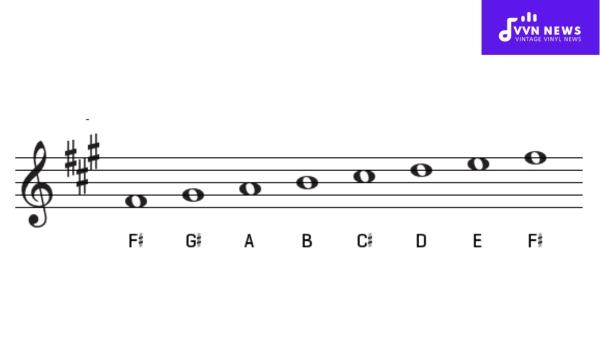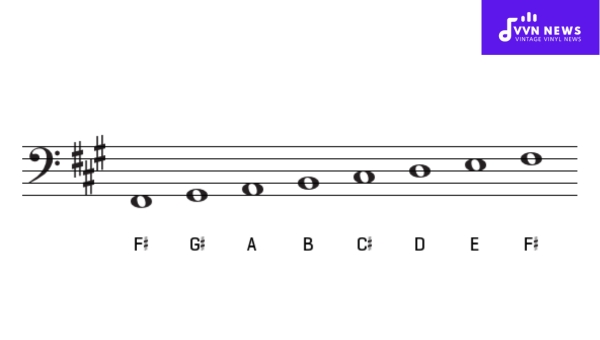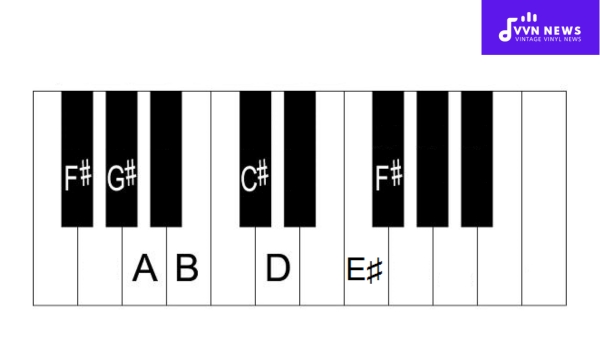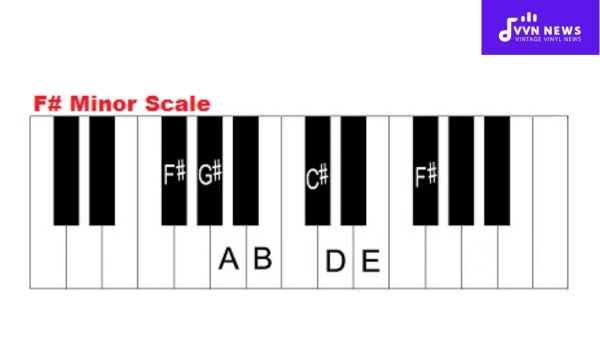Discovering the hidden corners of music can be an intellectual delight. The world of music serves as an escape for many, and among its secret maps, the F sharp minor scale occupies a special place.
It charms you with its unique somber yet expressive sound. Today, I want to take you on a journey through this mysterious but captivating world – the beautiful landscape of the F sharp minor scale.
You don’t have to be Mozart or Bach to tread this path. As you join me in exploring this distinctive musical element, together we’ll unravel its elements— from simple key signatures to thought-provoking compositions that have leveraged this scale, creating stunning pieces of music that are universally adored.
How do you derive the F Sharp Minor Scale?
The beauty of the F sharp minor scale can be unveiled using a specific pattern of tones and semitones.
For those unfamiliar, a ‘tone’ is equivalent to two half-steps on a musical instrument, and a ‘semitone’ represents a single half-step.
The formation pattern for this specific scale follows the sequence – Tone, Semitone, Tone, Tone, Semitone, Tone, and Tone (T-S-T-T-S-T-T).
Let’s break it down in simpler terms:
- Start with the Root Note: Our foundation or start point is naturally the F sharp note. This root note sets off our exploration.
- First Interval – A Tone: The first interval departs from F sharp by a full tone to reach G sharp.
- Second Interval – A Semitone: We then ascend a semitone from G sharp to hit A.
- Third And Fourth Intervals – Two Tones: The next two intervals follow the same structure – full tones that push us up the ladder from A to B and then B to C sharp.
- Fifth Interval – A Semitone: After reaching C sharp, we ascend by only half step this time round and land on D.
- Sixth And Seventh Intervals – Two Tones: Finally we gear up for the last leg of our journey with two full tones taking us from D to E and then E lands us on our final stop at F sharp which completes our scale.
What makes this process fascinating is that it introduces you to systematically building scales based on simple stepping-stone patterns.
Now that you know how the F sharp minor scale derives from a series of specific sequences, feel free to explore this beautiful scale in different forms of music.
You can find its echoes in various musical pieces and even attempt to create your own.
What are the constituent degrees of the F Sharp Minor Scale?

The F sharp minor scale, much like other scales in music, is composed of seven unique degrees or steps.
Each degree represents a particular position on the scale, and it can significantly alter the mood and feel of a musical composition when used appropriately.
Here’s a breakdown of the constituent degrees:
- Tonic – F# (prime)
- Supertonic – G# (second)
- Mediant – A (third)
- Subdominant – B (fourth)
- Dominant – C# (fifth)
- Submediant – D (sixth)
- Leading Tone/Subtonic – E (seventh)
These distinctive degrees not only ensure the scale’s versatility but also make it an attractive option for various composers across genres and periods.
Also Read: C Sharp Minor Scale [Master This Mood-Setting Musical Key]
How can one play F Sharp Minor Scale on the piano and guitar?
The beauty of the F sharp minor scale, with its melancholic yet expressive resonance, is appreciated by musicians worldwide.
Learning to bring out its essence on two popular instruments: the piano and guitar, can be an enriching experience indeed.
Playing the F Sharp Minor Scale on Piano
The F Sharp minor scale, also denoted as F# minor, is a unique melodic collection that can be quite exquisite on the piano.
Here are inclusive steps to play it.
- Start by locating the F# key on your piano. You’ll find it as the first black key in a group of three black keys.
- Next, press the F# key with your thumb (the most conventional way to kick off playing scales).
- Follow with G#, A, B, and C# using your next four fingers (index, middle, ring, and little finger) respectively. This resolves half of the scale.
- Now comes a little twist with other fingers: you are required to play D using your thumb again, E with your index finger, and complete the scale by pressing F# with your middle finger.
That’s an octave – from one F# to another! The beautiful pattern that echoes deep within the soul embodies melancholy and charm at once.
Repeat this sequence as many times as you want, each time getting more familiar and effortless.
Playing F sharp Minor Scale on Guitar
When you plan to articulate musical symphonies through strings rather than keys, don’t worry – I’ve got you sorted!
F sharp minor can produce some compelling sounds on guitar too.
- Start by finding the F# note on the low E string of your guitar which is located at the second fret.
- From there, proceed up two frets along the low E string till you reach the fourth fret (this is G#).
- Press A down at the fifth fret then hop onto B at the seventh fret; let’s say ‘hello’ to the middle two strings now!
- On A string press C#, then hop along two frets reaching D which happens to be the seventh fret itself; now we’re halfway there!
- Switch onto the D string now, pushing down E at the second fret, and finally give F# (fourth fret) a touch. This finalizes your minor journey through the F# scale on the guitar!
The F sharp minor scale holds an exclusive position in the realm of music with its captivating aura and you should never hesitate to venture deep into this world.
How is the F Sharp Minor Scale represented in different clefs?

The F sharp minor scale, with its particular moodiness and rich intensity, can be notated in different clefs based on the instrument you’re playing or the vocal range you’re working with.
This contributes to making your music compositions more distinct and your performances more stirring.
In our discussion, we’ll examine how the F sharp minor scale is represented in the Treble Clef (G Clef), Bass Clef (F Clef), and Alto Clef (C Clef).
Treble Clef
When transcribed in the treble clef, the F sharp minor scale appears to be a musical staff dominated by sharps.
It includes six of them, and the notation sequence will be: F#, G#, A, B, C#, D, E, and F#.
The treble clef is favored in transcription for high-range instruments like flutes or violins and high-pitched voices.
Bass Clef
Bass Clef notates lower sound ranges; hence it is commonly used for basses and instruments like cellos, trombones, and bassoons.
Within this clef’s staff lines and spaces, the notes forming the F sharp minor scale are transcribed as follows: F#, G#, A, B, C#, D, E, then finally ending on F#.
Alto Clef
Although less commonly used than treble or bass clefs, alto clef still holds importance, particularly in viola music or any instrument that resides midway between a viola’s and a cello’s range.
Here’s how you can note down an F sharp minor scale in alto clef: we initiate with F# (on the 2nd line from the top), then follow with G# (3rd space), A (3rd line), B (4th space), C# (4th line), D (5th space), E (space above the staff) to complete with the octave marker at an F#.
The one commonality amongst these diverse conventions of notation lies in their sequential adoption of notes.
The notations might appear differing based on each distinct clef but what binds them together is the basic essence underlying every musical piece – its adherence to structure while entertaining creativity and its universal language that reaches out irrespective of geographies.
Also Read: D Minor Scale Explained [Dive Into The Depths Of This Melody]
What is the proper key signature for the F Sharp Minor Scale?
The key signature of an F# minor scale is quite distinct, featuring a compelling lineup of sharps.
It includes six sharps: F#, G#, A#, B, C#, and D#. When it comes to notation, this mix of sharps makes the F# minor scale hauntingly beautiful.
Knowing your key signatures and how to identify them is crucial in music theory.
This signature helps you decipher the melodic and harmonic minor variations in the score perfectly.
You’ll witness these six sharps in both its relative major key (A major), and while playing this passionate and emotive scale itself, on any instrument you choose.
The major key corresponds to the F Sharp Minor Scale

Every minor key share a unique relationship with a certain major key, we call this phenomenon ‘relative keys’.
In the case of the F sharp minor scale, it is intimately linked to the A Major scale. Both scales share the same set of notes and key signatures.
They start from different root notes – A Major begins with “A” while F sharp minor kicks off with “F#”.
Keep in mind that recognizing this connection will greatly contribute to your grasp of scales and their implementation in various pieces of music.
What are the common chords in the F Sharp Minor Scale?
In the landscape of the F Sharp minor scale, several chords make up its topography. They form part of this scale’s distinct sonic identity. The most common chords include:
- F# minor (I): F# – A – C#
- G# diminished (ii°): G# – B – D
- A major (III): A – C# – E
- B minor (iv): B – D – F#
- C# minor (v): C# – E – G#
- D major (VI): D – F# – A
- E major (VII): E – G# – B
These are just some of the building blocks that come together to formulate the moody, expressive sound associated with compositions in this sonorous scale.
Also Read: F Minor Scale Explained [Step-By-Step Guide To Mastering Scales]
FAQs About The F Sharp Minor Scale
What notes make up the F Sharp Minor Scale?
The F Sharp Minor Scale consists of the notes F#, G#, A, B, C#, D, and E.
How is the F Sharp Minor Scale represented on a guitar?
Tabs can be used to represent this scale on a guitar. In fact, in tabs for the scale, fretted positions coincide with notes, starting from F# at fret 2 of the low E string.
Does the F Sharp Minor Scale have any distinctive characteristics?
Indeed, it does. Its defining characteristic is its emotional depth – it is often associated with feelings of sadness or melancholy.
What popular pieces of music have utilized the F Sharp Minor Scale?
This scale has been used in many famous compositions such as ‘Für Elise’ by Beethoven and Chopin’s ‘Nocturne in E minor’.
Which major scale corresponds to the F sharp minor scale?
The corresponding major key for the F sharp minor scale is A major.
Conclusion
Stepping into the realm of the F sharp minor scale can truly broaden your musical horizons.
Its rich, emotive sound can inspire not just seasoned musicians, but any music lover willing to delve into it.
The depth it adds to your musical knowledge is immeasurable. So whether you’re a novice guitarist, practicing pianist, or simply an ardent music admirer, taking the time to appreciate this enchanting minor scale will indeed open your senses to more beautiful layers of music’s timeless tapestry.
With practice, curiosity, and a keen ear, you are certain to master the art of playing in F sharp minor quickly and confidently!








